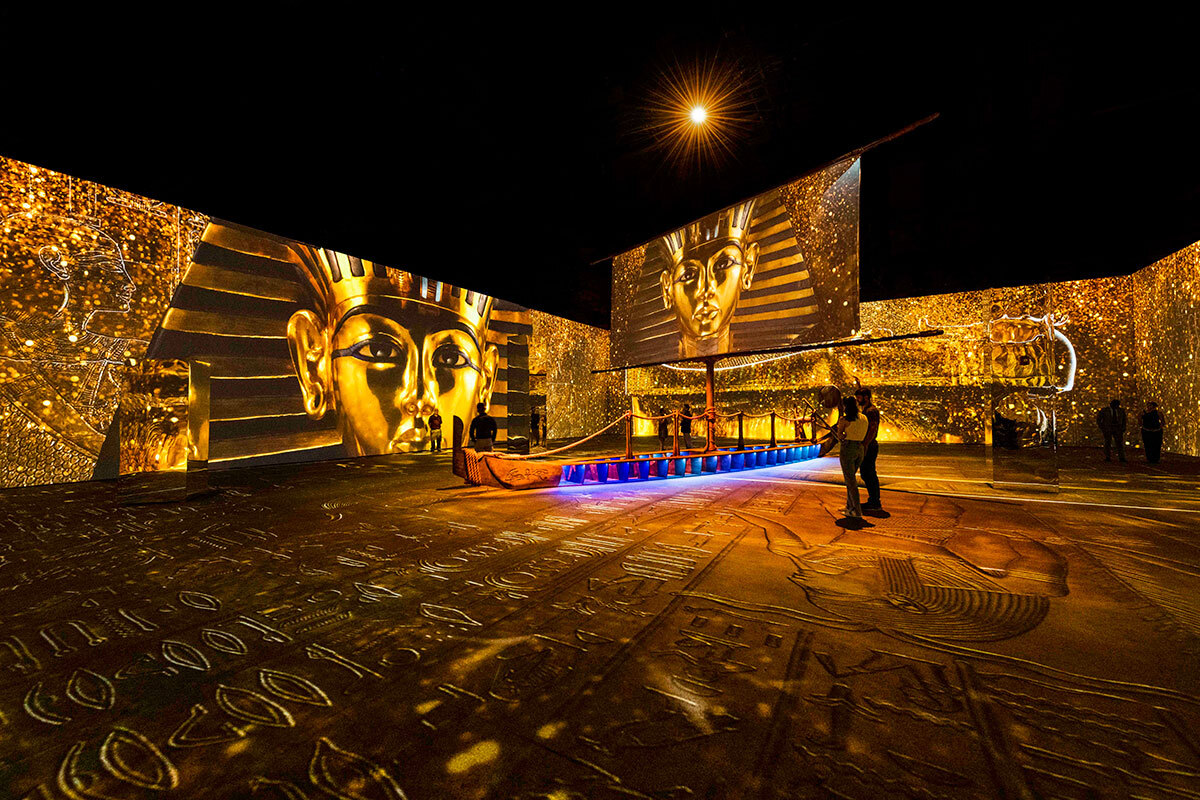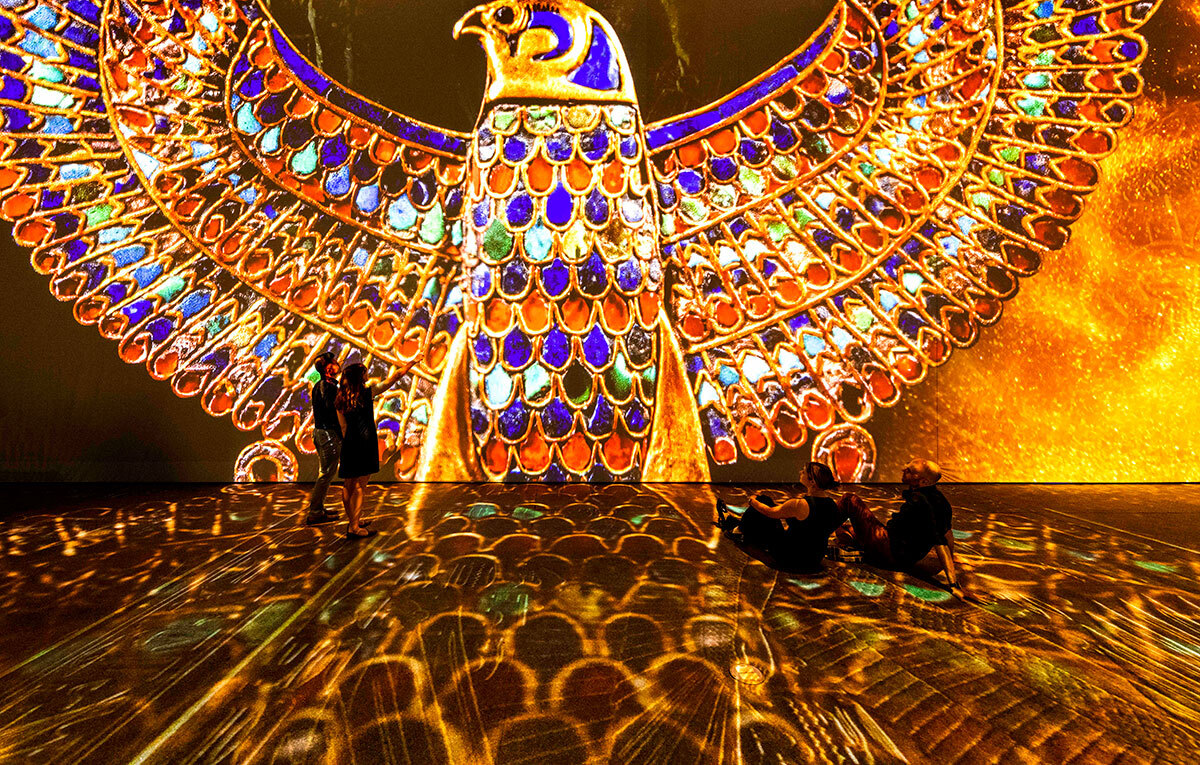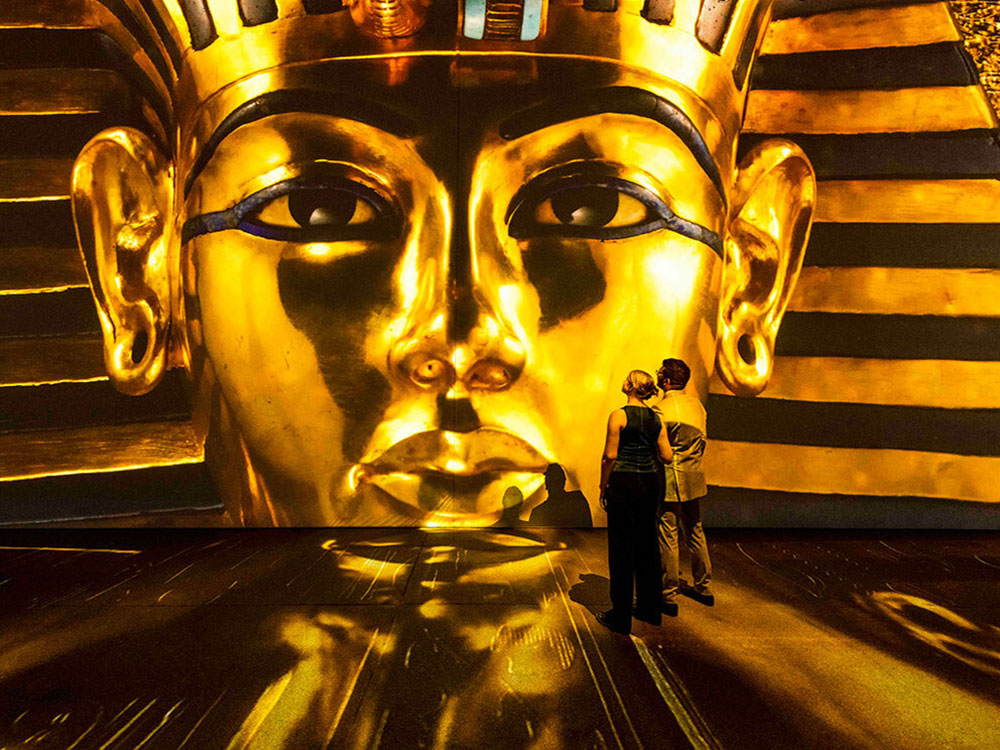There is the thing. And then there is the copy of the thing. And then, finally, there is the immersive experience of the thing of the thing.
What am I talking about?
Beyond King Tut, currently in situ at Canada Place, is another of the immersive travelling shows from the same folks who brought the highly Instagrammable Van Gogh show to Vancouver last year.
Opening on the eve of the 100th anniversary of the discovery of the ancient Egyptian pharaoh’s tomb on Nov. 4, 2022, and running until Jan. 8, 2023, Beyond comes at an interesting moment.
The possibility of exhuming any more information about the exhaustively explored boy king might seem impossible at this point in history. Hasn’t everything that could possibly be analyzed already been done? Strangely enough, there are still new developments and new discoveries taking place.
But take even the tiniest toe dip into the story of Tutankhamun and before you know it, you’re up to your eyeballs in differing opinions and versions of the story — from the discovery of the tomb itself to the reasons for the young ruler’s death at age 19. The initial view of Tut as a sickly youth, for example, has since been revised.
A new version of Tut as an adventurous soul, passionate about hunting has emerged. The different hypothesis on how he died has even expanded to include a possible accidental death due to an open wound on his leg at the time of his demise. Interpretations have continued to shift as new evidence comes to light and older theories are laid to rest.
Some of this expansive information is on display in Beyond, but it mostly sticks to the main storyline.
In short: after investing years searching in the Valley of the Kings, archeologist and Egyptologist Howard Carter was close to losing the support of his wealthy patron, the Earl of Carnarvon. Clues about the reign of a hitherto little-known ruler had popped up in earlier excavations. But Theodore Davis, the leading archeologist of the day, declared there was nothing of significance in the Valley of the Kings and decamped from the field. This proved to be a golden opportunity for Carter, who began a careful search. On Nov. 4, 1922, a worker from his team discovered a single stone step, largely obscured by debris and hidden beneath old huts. The stone steps led down to a sealed doorway, and so it began.
After the discovery of the tomb, Tut mania circumnavigated the globe, creating a firestorm of interest in Egyptology. This fascination never really went away. Some of the photos in Beyond detail the different tours including the 1961 exhibition at the National Gallery of Art in Washington, D.C., opened by Jackie Kennedy. Other photographs document the massive lineups to see the show in cities around the world.
It’s hard to suppress the deep fascination that the discovery still invokes. There is a goodly whiff of it in Beyond. Even though I knew I was standing in the ordinary setting of the Vancouver Convention Centre with its practical carpet and draped-off walls, all the hairs on the back of my neck stood at attention as I read about the opening of the burial site.

In his book, The Tomb of Tutankhamen, Carter described the moment he unblocked part of the sealed entrance and looked into the tomb to see statuary, furniture and disassembled chariots all piled high: “At first I could see nothing, the hot air escaping from the chamber causing the candle flame to flicker, but presently, as my eyes grew accustomed to the light, details of the room within emerged slowly from the mist, strange animals, statues and gold — everywhere the glint of gold.”
More than 5,000 different objects were eventually recovered from the different burial chambers, with Carter carefully cataloguing each item as it was removed.
The most famous of all, the image that has come to be synonymous with the entire saga, is the solid gold death mask of the young pharaoh. Despite the maddening familiarity of this visage, it is still the most extraordinary thing. Its beauty alone is enough, but it’s the mysterious quality that attends the golden face — the curious, half-smirking smile, the finely sculpted nose and large kohl-rimmed eyes — that fascinates. Even in reproduction, its power is impossible to deny. The image occurs frequently throughout the Beyond exhibition, but every time it popped up, it stopped me in my tracks.
Like the Van Gogh immersive show, Beyond is organized into several different graduated spaces. In some fashion, it echoes the opening of the tomb itself. In a small antechamber, an introductory film lays out the guts of the story before a sliding door opens and ushers attendees into a series of passages lined with archival photos and news clippings from the era. The larger rooms contain images of objects discovered in the tomb.
The experience is capped off in the largest space, where a full-size replica of an ancient Egyptian boat takes pride of place. But here is where things go slightly off the rails with an animated treatment of Tut’s journey to the afterlife, attended by a pantheon of the Gods (Re and the gang). There are battles with the serpent god and then finally the glories of paradise, which looks a lot like the landscape of Egypt.

If the show’s intention is to bring the faith practices of the ancient Egyptians to life, it’s a little too cartoonish in every sense of the word to really impart the gravity and strangeness of the sacred death rituals. But even the goofiest of the goofy stuff doesn’t detract from how the objects themselves innately fascinate. The murals that graced the walls of the tomb are filled with protective goddesses. In one painting, 12 baboons denote each hour of the night. A translucent yellow-green jewel in the pharaoh’s scarab chest-plate, formed from a meteorite impact, radiates a strange iridescence.
But even the most mundane things, like Tut’s childhood toys, games, sandals and walking sticks (the pharaoh was buried with more than 100 different canes) possess a curious spirit. More intimate things, like the gold finger and toe stalls that graced Tut’s mummified body are especially compelling. Perhaps it’s because they are so physical; they’re a poignant reminder that this was a real person, a young man, probably a lot like most young men.
Due to his early and unexpected death, the young king’s funeral rites were something of a rush job. This suddenness also reveals why the tomb lay undisturbed for so long. The heaped piles of objects speak to a hasty burial, as well as the fact that the plaster was still damp when the tomb was sealed as evidenced by creeping brownish mold on the walls.
The industry that grew up around the story of Tut’s tomb spawned countless books, films and articles, along with a goodly portion of mythologizing. The death of the Earl of Carnarvon who shaved off the top of a mosquito bite and promptly died led to the infamous mummy’s curse. Author Jo Marchant’s book The Shadow King provides an excellent summation of these curious twirls and twists.
Even now, 100 years later, projected images of the treasure are enough to draw a crowd. This stuff still sells. Vancouver is currently blanketed in advertisements for the show. So, is it worth paying a visit to the Beyond exhibition? A qualified yes, if you can look past all the rather silly spectacle to the real things.
But of course, that’s the rub: the real things aren’t there.
The actual objects taken from the tomb are no longer touring, so this is your best chance to look at them in large scale, short of visiting the new Grand Egyptian Museum, just outside of Cairo where all 5,000 of the artifacts will be permanently housed.
Is seeing only copies and sometimes copies of copies enough? Strangely yes. No matter how far removed, the singular power of the original thing still reaches out, haunting even the most mundane replication.
Nowhere is this more evident than in the glorious golden mask, with its human half-smile and thousand-year stare. Much like other iconic visages, think the Mona Lisa, no matter how many times it is reproduced, some seed of wonder endures. At the centre of it all, this young man, encased in golden silence, still speaks.
'Beyond King Tut' is on at Canada Place until Jan. 8, 2023. ![]()

















Tyee Commenting Guidelines
Comments that violate guidelines risk being deleted, and violations may result in a temporary or permanent user ban. Maintain the spirit of good conversation to stay in the discussion.
*Please note The Tyee is not a forum for spreading misinformation about COVID-19, denying its existence or minimizing its risk to public health.
Do:
Do not: